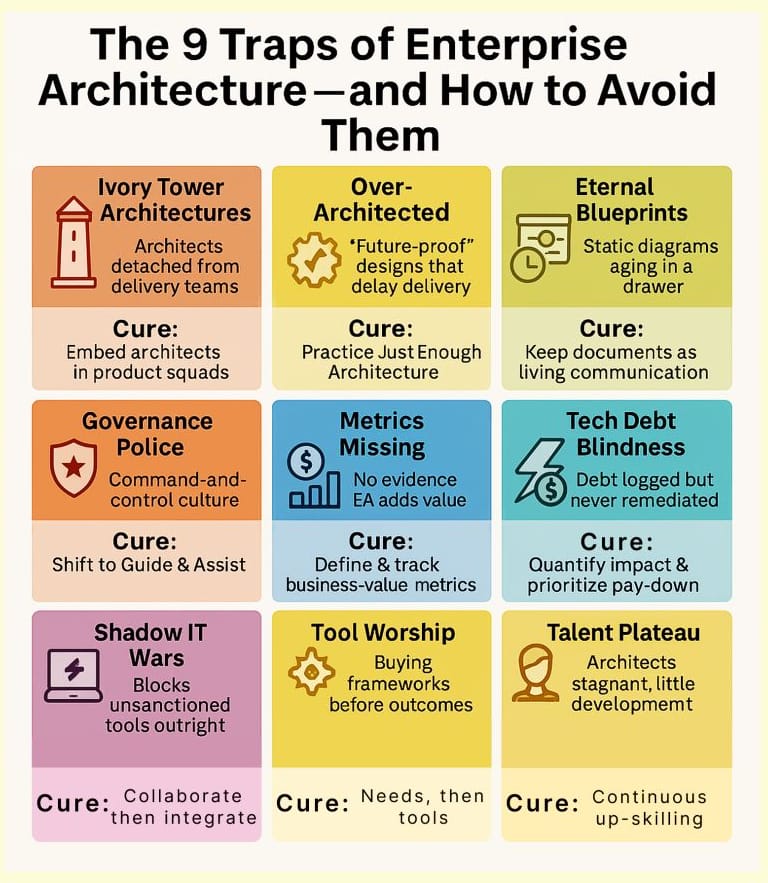Community Comment: Part 40 - Being bold & clear helps avoid the traps of enterprise architecture
- Enterprise architecture traps and how to avoid them
- Be bold and direct when it comes to describing traps and cures
- Ivory tower architectures are traps, but who actually creates architectures?
- If you want to make progress, avoid usage of unclear or circular definitions

The comments I provided in reaction to a community discussion thread.
Chief Architect at Dutch Consulting Firm:
𝟵 𝐓𝐫𝐚𝐩𝐬 𝐨𝐟 𝐄𝐧𝐭𝐞𝐫𝐩𝐫𝐢𝐬𝐞 𝐀𝐫𝐜𝐡𝐢𝐭𝐞𝐜𝐭𝐮𝐫𝐞 — 𝐚𝐧𝐝 𝐡𝐨𝐰 𝐭𝐨 𝐬𝐢𝐝𝐞𝐬𝐭𝐞𝐩 𝐭𝐡𝐞𝐦
Following up the “12 𝙇𝙖𝙬𝙨 𝙤𝙛 𝙀𝙣𝙩𝙚𝙧𝙥𝙧𝙞𝙨𝙚 𝘼𝙧𝙘𝙝𝙞𝙩𝙚𝙘𝙩𝙪𝙧𝙚”, I wanted to flip the perspective:
👉 What are the patterns that consistently lead EA teams into trouble?
These aren’t abstract risks.
They show up in the wild, on stalled initiatives, in orgs with no trust in EA, or in tooling graveyards. And often, they’re subtle:
• 𝗜𝘃𝗼𝗿𝘆 𝗧𝗼𝘄𝗲𝗿 𝗔𝗿𝗰𝗵𝗶𝘁𝗲𝗰𝘁𝘂𝗿𝗲𝘀 — beautiful diagrams, but no influence on real delivery
• 𝗢𝘃𝗲𝗿-𝗔𝗿𝗰𝗵𝗶𝘁𝗲𝗰𝘁𝗲𝗱 — “𝘧𝘶𝘵𝘶𝘳𝘦-𝘱𝘳𝘰𝘰𝘧” designs that stall progress before value hits
• 𝗘𝘁𝗲𝗿𝗻𝗮𝗹 𝗕𝗹𝘂𝗲𝗽𝗿𝗶𝗻𝘁𝘀 — static diagrams that no one updates or uses
• 𝗚𝗼𝘃𝗲𝗿𝗻𝗮𝗻𝗰𝗲 𝗣𝗼𝗹𝗶𝗰𝗲 — control-heavy culture that creates blockers, not support
• 𝗠𝗲𝘁𝗿𝗶𝗰𝘀 𝗠𝗶𝘀𝘀𝗶𝗻𝗴 — no hard proof EA creates impact or justifies its existence
• 𝗧𝗲𝗰𝗵 𝗗𝗲𝗯𝘁 𝗕𝗹𝗶𝗻𝗱𝗻𝗲𝘀𝘀 — everyone logs the debt, no one pays it down
• 𝗦𝗵𝗮𝗱𝗼𝘄 𝗜𝗧 𝗪𝗮𝗿𝘀 — a defensive stance toward unsanctioned innovation
• 𝗧𝗼𝗼𝗹 𝗪𝗼𝗿𝘀𝗵𝗶𝗽 — tools and frameworks bought before needs are clear
• 𝗧𝗮𝗹𝗲𝗻𝘁 𝗣𝗹𝗮𝘁𝗲𝗮𝘂 —architects stuck, unchallenged, and slowly falling behind
These traps are habits, blind spots, and culture patterns that quietly erode EA’s credibility and impact. The graphic pairs each with a “cure” we’ve seen work in the field.
𝐖𝐡𝐚𝐭 𝐝𝐢𝐝 𝐈 𝐦𝐢𝐬𝐬?
Add your “Trap #10” in the comments. Let’s expand this into a crowdsourced anti-pattern catalog for architects.
🧭 Avoid the traps. Spread the cures.
Gfesser:
My suggestion is to be a little more bold with #1, changing this to "Ivory tower architects" from "Ivory tower architectures". Also, #1 and #2 both mention "architecture" without defining it, with #2 also mentioning "designs". While I understand that these descriptions are intended to be very high level summaries, what these two terms mean still tends to result in much debate: perhaps a couple footnotes would help, or even better, provide descriptions of these two traps that don't involve circular definitions.
Chief Architect at Dutch Consulting Firm:
Good callout Erik.and you're right, precision matters, especially up front.
Tempting suggestion to shift #1 to “Ivory Tower Architects” — it puts accountability where it belongs. And yes, the terms “architecture” and “design” carry a lot of baggage.
Simplifying the language might be a better path here. Appreciate the thoughtful push for clarity!